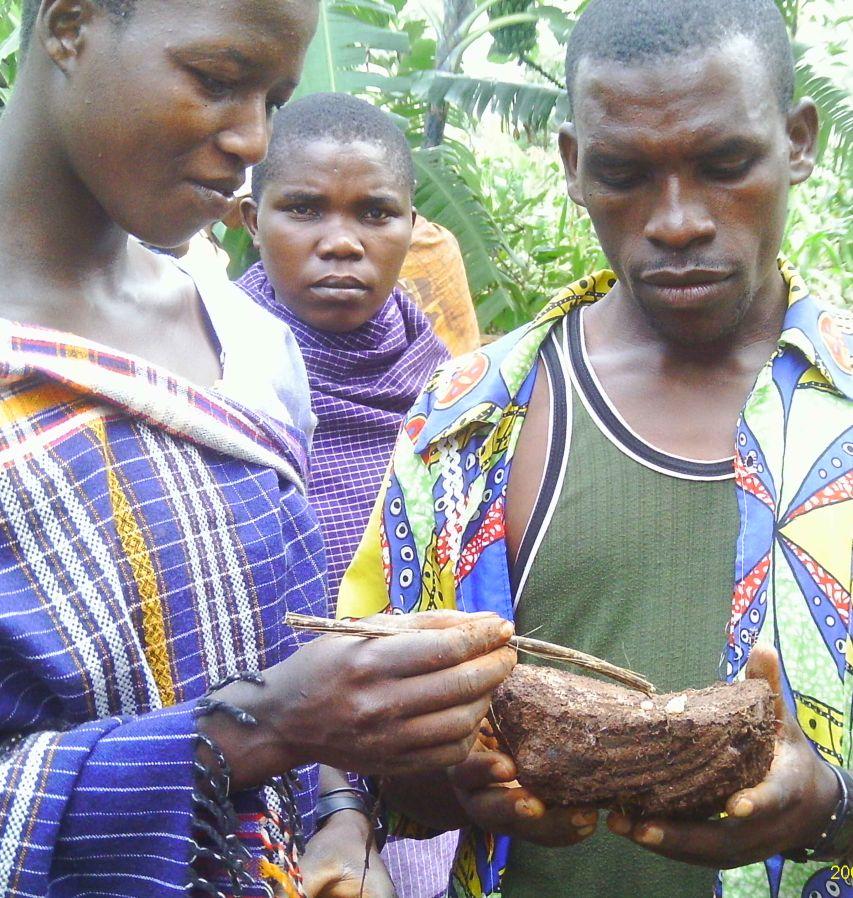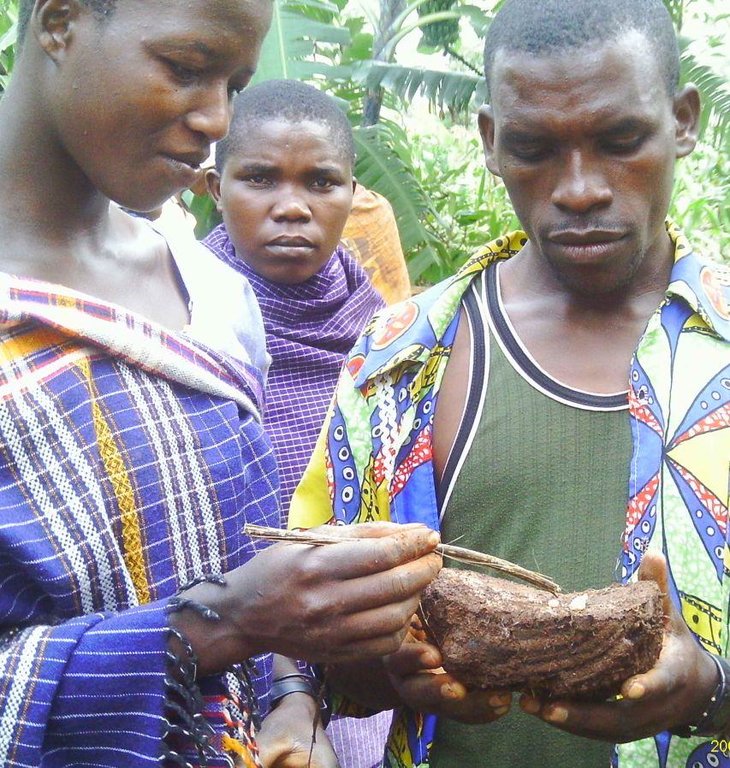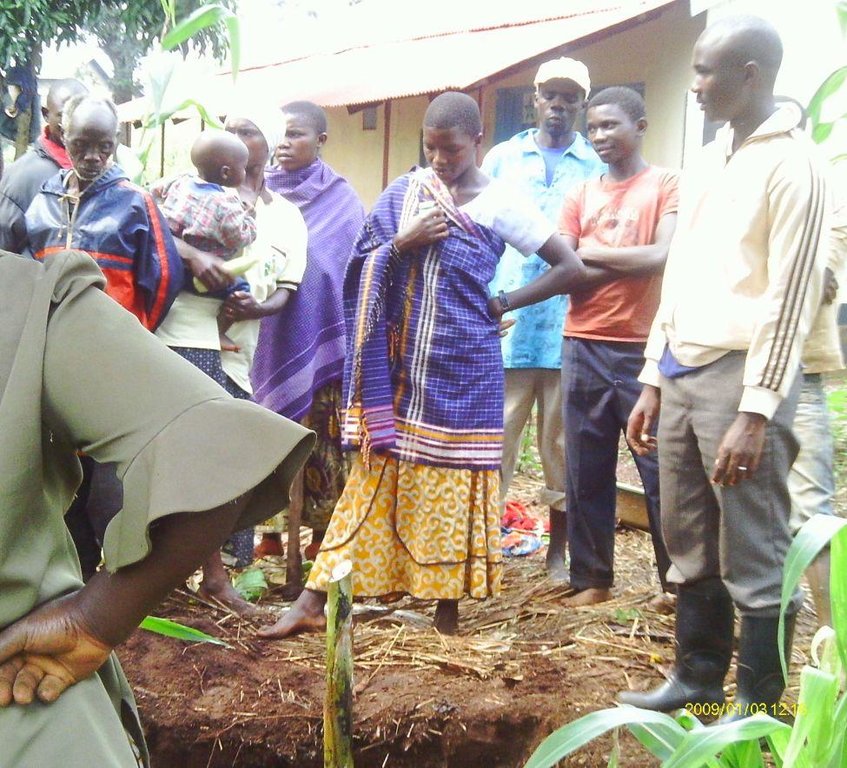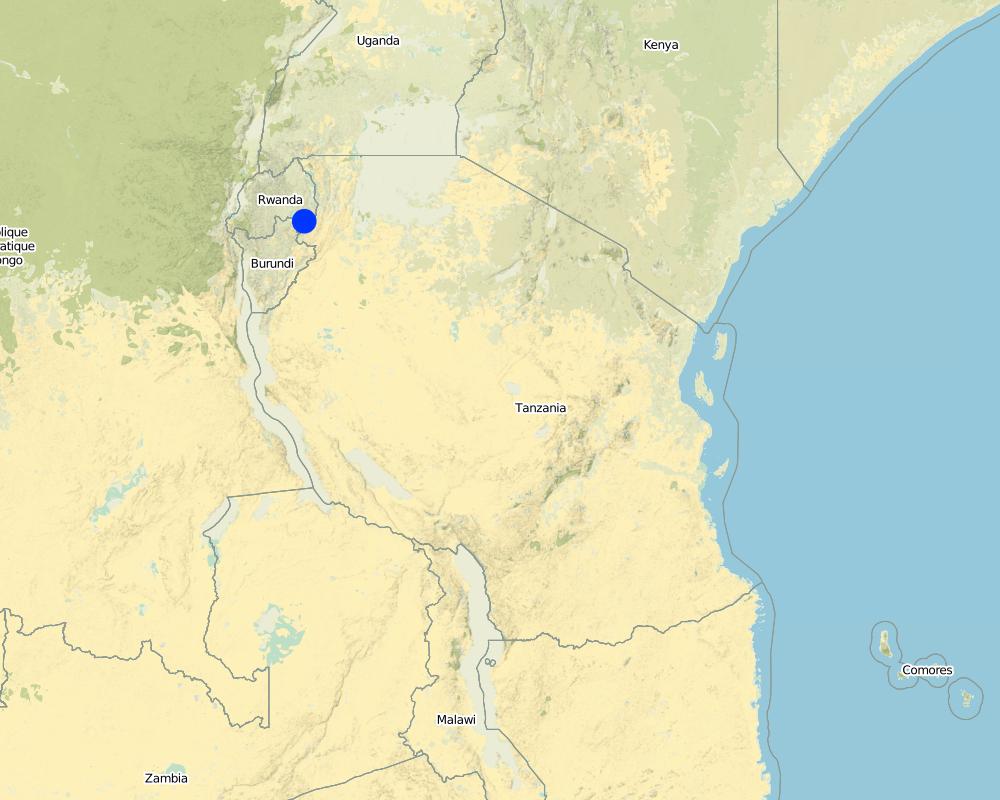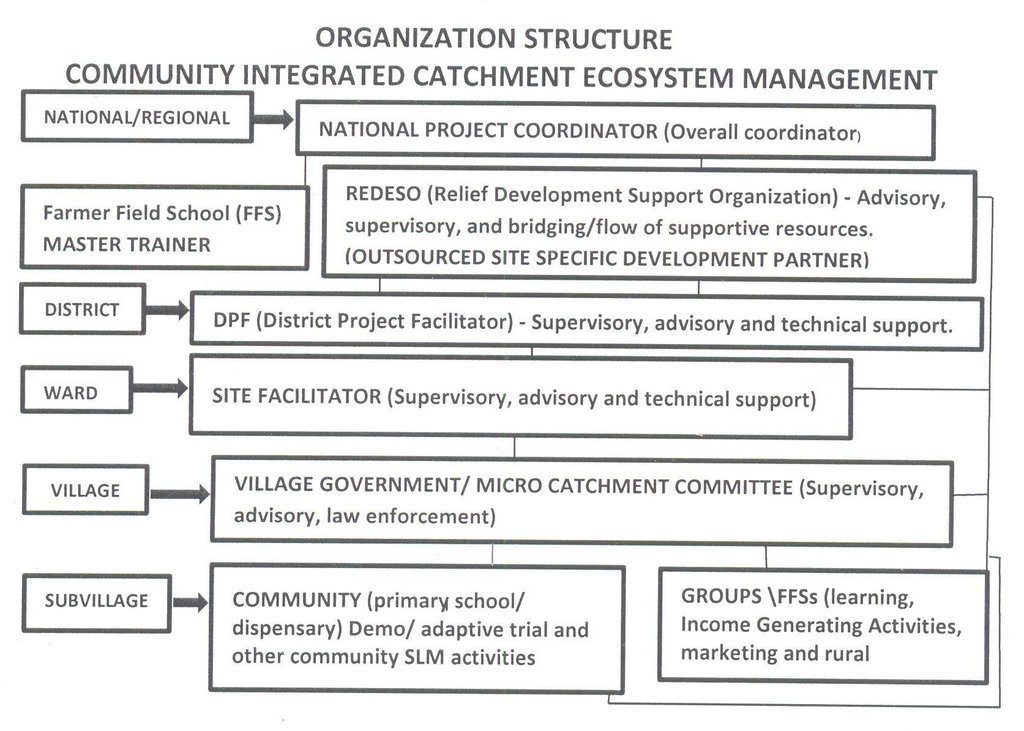Community intergrated catchment ecosystem management [Tanzania, República Unida de]
- Creación:
- Actualización:
- Compilador: ALLAN BUBELWA
- Editor: –
- Revisor: Fabian Ottiger
Mfumo wa usimamizi wa ekolojia katika eneo bonde (Swahili)
approaches_2486 - Tanzania, República Unida de
Visualizar secciones
Expandir todo Colapsar todos1. Información general
1.2 Detalles de contacto de las personas de referencia e instituciones involucradas en la evaluación y la documentación del Enfoque
Especialista MST:
Especialista MST:
Especialista MST:
Mwasikundima Idephonce
Ngara District Council
Tanzania, República Unida de
Nombre de la(s) institución(es) que facilitaron la documentación/ evaluación del Enfoque si fuera relevante)
Bukoba district council (Bukoba district council) - Tanzania, República Unida deNombre de la(s) institución(es) que facilitaron la documentación/ evaluación del Enfoque si fuera relevante)
Ngara District Council (Ngara District Council) - Tanzania, República Unida de1.3 Condiciones referidas al uso de datos documentados mediante WOCAT
¿Cuándo se compilaron los datos (en el campo)?
10/03/2014
El compilador y la/s persona(s) de referencia claves aceptan las condiciones acerca del uso de los datos documentados mediante WOCAT :
Sí
1.4 Referencia/s al/los Cuestionario(s) de Tecnologías MST
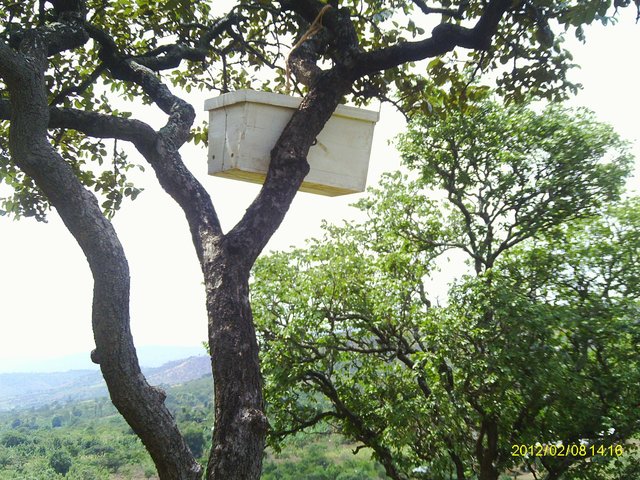
Natural forest conservation using apiaries [Tanzania, República Unida de]
Establishment of apiaries in natural forests to retard forest mismanagement and improve honey production
- Compilador: Philip Ileta
2. Descripción del Enfoque MST
2.1 Breve descripción del Enfoque
Adaptive Agro-ecosystem Micro-catchment Approach.
2.2 Descripción detallada del Enfoque MST
Descripción detallada del Enfoque MST:
Aims / objectives: SLM knowledge skill generation and capacity building. Improved group and community strength, sustainability, organization and their capacity to benefit and invest in SLM. Motivation of community participation in SLM through use of quick win project, income generating activities, rural micro finance institutions, marketing and active engagement of disadvantaged groups.
Methods: Wider promotion of basket of choice of SLM technologies through SLM Farmer Field School, Demonstration plots and community related activities. Make use and build on already existing and new groups, existing institutions and the community as a whole. Strategic use of easily available and accessible available community institutions/ infrastructures (school and dispensaries sites) to demonstrate and promote basket of choice of SLM technologies. Learning by doing on the job, practical training, adoption and adaptation to local reality.
Stages of implementation: Site characterization through land degradation analysis (LADA) and development of community site specific SLM plan exemplifying SLM interventions needed to address the identified degradation types. Set up and identification of approaches needed to execute identified interventions complementary approaches. Sensitization and awareness creation to the community and actual execution of approaches.
Role of stakeholders: Individual groups: are core implementers and potential beneficiaries of the project.
Extension worker: Advisory and technical backstopping.
Elected and employed leaders at the sub-village, village and ward level: bylaw/law enforcement, supervisory and land provision.
Relief for Development Societies NGO (REDESO): Service provision and development partner in SLM.
Trans boundary Agro-ecosystem Management Project (TAMP): Provision of supportive resources (financial and technical).
Ngara district council: Supervisory, technical, policy interpretation, monitoring and evaluation, documentation, analysis and shairing .
Rugenge/Kirusha Micro catchment Committee: Supervisory, advisory and law enforcement.
2.3 Fotos del Enfoque
2.5 País/ región/ lugares donde el Enfoque fue aplicado
País:
Tanzania, República Unida de
Región/ Estado/ Provincia:
Tanzania
Especifique más el lugar :
Ngara
Map
×2.6 Fechas de inicio y conclusión del Enfoque
Indique año del inicio:
2010
Año de conclusión (si el Enfoque ya no se aplica):
2014
2.7 Tipo de Enfoque
- proyecto/ basado en un programa
2.8 Propósitos/ objetivos principales del Enfoque
The Approach focused mainly on SLM with other activities (Motivating quick win income generation activities, rural microfinance institutions, marketing and HIV/AIDS controll.)
Knowledge/skill generation, demonstration and sustainability of SLM activities.
Motivate active participation of the community.
Inculcate a sense of community ownership/ community take charge of SLM activities.
The SLM Approach addressed the following problems: Lack of technical knowledge
Low investment capacity
Malpractice and mismanagement of local resources (e.g. fire burning, ploughing along the slope).
Adequate supervision, monitoring and law enforcement.
2.9 Condiciones que facilitan o impiden la implementación de la/s Tecnología/s aplicadas bajo el Enfoque
normas y valores sociales/ culturales/ religiosos
- impiden
Negative cultural believes that fire burning can lead to one living long or reach older age.
Treatment through the SLM Approach: Change of mind set through FFS training, demos and community sensitization.
disponibilidad/ acceso a recursos y servicios financieros
- impiden
Low investment capacity and inability to access supportive resources
Treatment through the SLM Approach: Easy access to TAMP supportive resources.
entorno institucional
- impiden
Narrow coverage of the district, local institutions not involved in in SLM.
Treatment through the SLM Approach: Higher coverage, ope-rationalization of SLM in LGA system.
marco de trabajo legal (tenencia de tierra, derechos de uso de tierra y agua)
- facilitan
The existing land ownership, land use rights / water rights helped a little the approach implementation: Hindrance is usually observant for approaches which need long term commitment of land resources (e.g perennial crops) but is minimal for short term (annuals and biannual).
Open access land resources are difficult to manage.
- impiden
Reluctance of the village to issue land, less protection of open access land resources.
Treatment through the SLM Approach: land issuing for FFS/Demo use legally recognized through signing of Memorandum Of Understanding (MOU) between the village and land users/SLM groups. Bylaws reinforcement to protect mismanagement of open access land resources.
conocimiento de MST, acceso a apoyo técnico
- impiden
Inadequate understanding and use of SLM technical knowledge (both scientific and indigenous) to address land degradation problems.
Treatment through the SLM Approach: Up scaling use of scientific SLM knowledge.
Documentation, evaluation, analysis and sharing of successful indigenous SLM technical knowledge.
carga de trabajo, disponibilidad de mano de obra
- impiden
High workload to extension officers (due to their shortage).
Treatment through the SLM Approach: Build a local resource base in facilitating SLM activities through introduction of community SLM facilitators and Micro-catchment committee.
otros
- impiden
Low motivation due to long term realization of SLM benefits.
Treatment through the SLM Approach: introduce SLM related quick win projects and income generation activities (IGA).
3. Participación y roles de las partes interesadas involucradas
3.1 Partes interesadas involucradas en el Enfoque y sus roles
- usuarios locales de tierras/ comunidades locales
Core implementors. all gender, youth and elders . Widows, Orphans, People living with HIV/AIDS were actively indiscriminately involved in FFS, Demos and community related activities..
- especialistas MST/consejeros agrícolas
all gender, youth and elders
- profesores/ niños en edad escolar/ estudiantes
all gender, youth and elders
- ONG
dvisory, technical back stopping, supervisory and monitoring.
- gobierno local
Advisory, technical back stopping, supervisory and monitoring.
- gobierno nacional (planificadores, autoridades)
dvisory, technical back stopping, supervisory and monitoring.
- organización internacional
dvisory, supervisory and monitoring.
Si varias partes interesadas estuvieron involucradas, indique la agencia principal:
Land user (all genders, youth and elders): consulted and made informed decision about the approach to be used. National specialists: potential facilitators in designing and community sensitization. International specialists: consultative and subject matter specialist (e.g. FFS specialist)
3.2 Involucramiento de los usuarios locales de tierras/ comunidades locales en las distintas fases del Enfoque
| Involucramiento de los usuarios locales de tierras/ comunidades locales | Especifique quién se involucró y describa las actividades | |
|---|---|---|
| iniciación/ motivación | pasivo | Community, groups, employed and elected leaders: participated in sensitization and awareness creation process. |
| planificación | interactivo | Community, groups, employed and elected leaders: active participants and decision makers in planning e.g. selection of FFS community facilitators and formation of micro-catchment committee. |
| implementación | apoyo externo | Community, groups, employed and elected leaders: core and key implementers of the approach. |
| monitoreo y evaluación | interactivo | Community, groups, employed and elected leaders: self mobilized and client interactive monitoring. |
| Research | interactivo | Community, groups, employed and elected leaders: site identification and active implementers of adaptive trials (e.g use of fanya juu/chini terraces, vertivar grass e.t.c). Adopters, users and promoters of the best bets technologies. |
3.3 Flujograma (si estuviera disponible)
Descripción:
organization structure of community integrated catchment ecosystem management.
Autor:
Allan Isaka Bubelwa (Box 38 Kyaka Missenyi Kagera Tanzania)
3.4 La toma de decisiones en la selección de Tecnología(s) MST
Especifique quién decidió la selección de las Tecnología/ Tecnologías a implementarse:
- principalmente usuarios de tierras con el apoyo de especialistas MST
Explique:
Land users working in collaboration with SLM specialist through a participatory dialogue and decision making process.
Decisions on the method of implementing the SLM Technology were made by mainly by land users supported by SLM specialists. During inception of the project, land users were actively involved in deciding on the type of method to adopt e.g. selection of site and test crops for FFS, Demo and community related SLM activities.
4. Apoyo técnico, fortalecimiento institucional y gestión del conocimiento
4.1 Construcción de capacidades / capacitación
¿Se proporcionó la capacitación a usuarios de tierras/ otras partes interesadas?
Sí
Especifique quién fue capacitado:
- usuarios de tierras
- personal de campo/ consejeros
- employed and elected leaders
Si fuese relevante, también especifique género, edad, estatus, etnicidad, etc.
Both gender, all age (youth and elders)
Forma de capacitación:
- en el contexto de trabajo
- de agricultor a agricultor
- áreas de demostración
Temas avanzados:
SLM related subjects
4.2 Servicio de asesoría
¿Los usuarios de tierras tienen acceso a un servicio de asesoría?
Sí
Especifique si servicio proporcionado se realizó:
- en los campos de los usuarios de tierras
Describa/ comentarios:
Name of method used for advisory service: Farmer field schools (FFS); Key elements: Practical training and learning by doing., Basket of choice of Technologies/Demos., Group oriented and site specific; Adoption depends on farmers choice and ability to invest.
Advisory service is inadequate to ensure the continuation of land conservation activities; There is limited knowledge and low funding capacity.
4.3 Fortalecimiento institucional (desarrollo institucional)
¿Se establecieron o fortalecieron instituciones mediante el Enfoque?
- sí, moderadamente
Especifique el nivel o los niveles en los que se fortalecieron o establecieron las instituciones:
- local
Especifique el tipo de apoyo:
- construcción de capacidades/ entrenamiento
Proporcione detalles adicionales:
Training provision to micro-catchment committee.
4.4 Monitoreo y evaluación
¿El monitoreo y la evaluación forman parte del Enfoque?
Sí
Comentarios:
bio-physical aspects were ad hoc monitored by project staff, government, land users through observations; indicators: hactarage conserved
bio-physical aspects were ad hoc monitored by project staff, government, land users through measurements; indicators: hactarage conserved
technical aspects were regular monitored by project staff, government, land users through observations; indicators: number of adopters
technical aspects were regular monitored by project staff, government, land users through measurements; indicators: number of adopters
socio-cultural aspects were regular monitored by project staff, government, land users through observations; indicators: % involvement of women
socio-cultural aspects were regular monitored by project staff, government, land users through measurements; indicators: % involvement of women
economic / production aspects were regular monitored by project staff, government, land users through observations; indicators: % increase in yield and income
economic / production aspects were regular monitored by project staff, government, land users through measurements; indicators: % increase in yield and income
area treated aspects were regular monitored by project staff, government, land users through observations; indicators: hactarage conserved
area treated aspects were regular monitored by project staff, government, land users through measurements; indicators: hactarage conserved
no. of land users involved aspects were regular monitored by project staff, government, land users through observations; indicators: number of adopters
no. of land users involved aspects were regular monitored by project staff, government, land users through measurements; indicators: number of adopters
management of Approach aspects were regular monitored by project staff, government, land users through observations; indicators: Number of FFS, Demos and IGA
management of Approach aspects were monitored through measurements; indicators: umber of FFS, Demos and IGA
There were several changes in the Approach as a result of monitoring and evaluation: Introduction of FFS farmer facilitators and Micro-catchment committees.
There were few changes in the Technology as a result of monitoring and evaluation: In the course of implementation adjusting or modifying technologies to suit agro-ecological condition or landforms
4.5 Investigación
¿La investigación formó parte del Enfoque?
Sí
- adaptive SLM trials
Proporcione detalles adicionales e indique quién hizo la investigación:
Adaptive SLM trials run by community/district/ARI Maruku through demos where farmers can select the best bets to apply and try on their own fields.
Research was carried out on-farm
5. Financiamiento y apoyo material externo
5.1 Presupuesto anual para el componente MST del Enfoque
Si no se conoce el presupuesto anual preciso, indique el rango:
- 10,000-100,000
Comentarios (ej. fuentes principales de financiamiento/ donantes principales):
Approach costs were met by the following donors: international (TAMP): 50.0%; government (Region/ARI Maruku.): 10.0%; local government (district, county, municipality, village etc) (Ngara district council, Villages and Ward): 20.0%; local community / land user(s) (Local community and groups withi the microcatchment ): 20.0%
5.2 Apoyo financiero/material proporcionado a los usuarios de tierras
¿Los usuarios de tierras recibieron financiamiento/ apoyo material para implementar la Tecnología/ Tecnologías? :
Sí
5.3 Subsidios para insumos específicos (incluyendo mano de obra)
- equipo
| Especifique qué insumos se subsidiaron | En qué grado | Especifique los subsidios |
|---|---|---|
| herramientas | totalmente financiado | Working gears (gun boots, raincoats, T-shirts) |
| Computers, cameras | totalmente financiado | |
- agrícola
| Especifique qué insumos se subsidiaron | En qué grado | Especifique los subsidios |
|---|---|---|
| semillas | parcialmente financiado | |
| fertilizantes | parcialmente financiado | |
| Manure | parcialmente financiado | |
- otro
| Otro (especifique) | En qué grado | Especifique los subsidios |
|---|---|---|
| Livestock | totalmente financiado | Chicken, goats and bees |
Si la mano de obra de usuarios de tierras fue un insumo sustancial, ¿fue:
- voluntario?
Comentarios:
labour was largely voluntarily and was rewarded indirectly by introduction of income generating activities.
Some inputs were fully financed, partly financed and not financed. Materials fully financed are those not available at the site or not adequately available or in shortage.
5.4 Crédito
¿Se proporcionó crédito bajo el Enfoque para actividades MST?
No
6. Análisis de impacto y comentarios de conclusión
6.1 Impactos del Enfoque
¿El Enfoque ayudó a los usuarios de tierras a implementar y mantener Tecnologías MST?
- No
- Sí, un poco
- Sí, moderadamente
- Sí, mucho
Knowledge and skill acquired through FFS, Demos and community related intervention played significant role in improvement of SLM. Bylaw reinforcement significantly prevented malpractices/land resource mismanagement.
¿El Enfoque empoderó a grupos en desventaja social y económica?
- No
- Sí, un poco
- Sí, moderadamente
- Sí, mucho
Improved to livelihood mechanism/alternates to widow, orphan and people living with HIV/AIDS
¿El Enfoque mejoró cuestiones de tenencia de tierra/ derechos de usuarios que obstaculizaron la implementación de la Tecnologías MST?
- No
- Sí, un poco
- Sí, moderadamente
- Sí, mucho
The approach involve signing of memorandum of understanding (MOU) over use of land resource between farmer groups running Demos and FFS and the village government. MOU is a strong and reliable legal acquisition of land resource to be used for conservation activities.
Did other land users / projects adopt the Approach?
- No
- Sí, un poco
- Sí, moderadamente
- Sí, mucho
On average each FFS member induced adoption to 2 household farmers.
Did the Approach lead to improved livelihoods / human well-being?
- No
- Sí, un poco
- Sí, moderadamente
- Sí, mucho
Diversification of income sources through introduction of Quick win income generating (IGA) AND
Did the Approach help to alleviate poverty?
- No
- Sí, un poco
- Sí, moderadamente
- Sí, mucho
Improvement of livelihood alternates and income, the situation is improve in the future.
6.2 Motivación principal del usuario de la tierra para implementar MST
- producción incrementada
increased production to meet daily needs and surplus for selling.
- incremento de la renta(bilidad), proporción mejorada de costo-beneficio
increased surplus and income accrued through surplus generation.
- well-being and livelihoods improvement
food security and income is the first priority.
6.3 Sostenibilidad de las actividades del Enfoque
¿Pueden los usuarios de tierras sostener lo que se implementó mediante el Enfoque (sin apoyo externo)?
- sí
Si respondió que sí, describa cómo:
Farmers have realized the benefit of SLM. The village historical track records and experience indicate that farmers in Kirusha village usually continue what ever they come to realize is implemented for their own benefit. Further more, establishment of local human resource in SLM in terms of FFS facilitators and micro-catchment committee and their ope-rationalization into LGA systems is an assure way towards sustainability.
Motivation induced through quick win income generating activities (goat production, chicken, piggery, fruit tree nurseries and apiaries) and easy to manage demo set at Kirushya primary school and dispensary (reachable and easily accessible) are added assurance for project sustainability.
6.4 Fortalezas/ ventajas del Enfoque
| Fuerzas/ ventajas/ oportunidades desde la perspectiva del usuario de la tierra |
|---|
| Learning and acquisition of knowledge (How to sustain/ enhance this strength: continuation of FFS, Demo and community activities.) |
| Cohesiveness and self help (How to sustain/ enhance this strength: Continue promotion of VICOBA and Market. ) |
| Spread of knowledge within and outside village. (How to sustain/ enhance this strength: Continue use of the approach. ) |
| Fuerzas/ ventajas/ oportunidades desde la perspectiva del compilador o de otra persona de referencia clave |
|---|
| Improved relationship, unity, cohesiveness and common voice. (How to sustain/ enhance this strength: Continue with promotion, strengthening and establishment of IGA, SACCAS and VICOBA.) |
| More farmers are involved (rapid adoption and expansion) (How to sustain/ enhance this strength: Up scaling and strengthening of FFS, Demos, and IGA. ) |
| The approach is cost effective (benefit surpass costs) (How to sustain/ enhance this strength: Promote, expand and continue use of FFS, Demos and IGA.) |
| Assured and promising elements of sustainability. (How to sustain/ enhance this strength: Strengthen ope-rationalization and use of micro-catchment committee and FFS facilitators. ) |
|
Easy access to supportive resources (Land and financial) (How to sustain/ enhance this strength: strengthen and liaise FFS with service providers (Bank, SACCOS and Marketing)) |
6.5 Debilidades/ desventajas del Enfoque y formas de sobreponerse a ellos
| Debilidades/ desventajas/ riesgos desde la perspectiva del usuario de la tierra | ¿Cómo sobreponerse a ellas? |
|---|---|
|
Negative customs and believes (it is believed that one can live longer and reach older age by setting fire and burning of a large area). |
Discourage negative custom and believes |
| Reluctance of household heads especially in patrimonial societies. | Community sensitization to gender (gender be addressed as the basic component of the approach). |
| Failure and negative experience of past development projects and programmes. | Change of mind set |
| Shortage of inputs and working facilities | Promote availability and accessibility of inputs and working facilities. |
| Debilidades/ desventajas/ riesgos desde la perspectiva del compilador o de otra persona de referencia clave | ¿Cómo sobreponerse a ellas? |
|---|---|
| Selfishness, individualism by some untrustworthy politicians and leaders. | Combine SLM promotion with civic education training. |
| Prone to natural calamities and disastrous events | Introduce and strengthen use of Agro-based insurance. |
| Largely relies on government or farmer willingness to release and offer land. | Sensitize and encourage use of MOU. |
| If not done in precaution can perpetuate dependency syndrome | Encourage use of self mobilized farmer groups and their strengthening and ope-rationalization into existing systems. |
| Reliable external supportive resource needed initially | Reliable and timely supply of supportive resources. |
7. Referencias y vínculos
7.1 Métodos/ fuentes de información
- visitas de campo, encuestas de campo
- entrevistas con usuarios de tierras
7.2 Referencias a publicaciones disponibles
Título, autor, año, ISBN:
Site characterization report: Kimamba Lyoba,
Vínculos y módulos
Expandir todo Colapsar todosVínculos

Natural forest conservation using apiaries [Tanzania, República Unida de]
Establishment of apiaries in natural forests to retard forest mismanagement and improve honey production
- Compilador: Philip Ileta
Módulos
No se hallaron módulos


